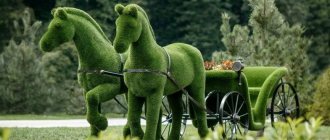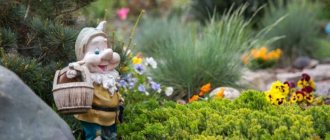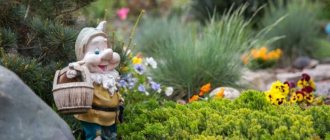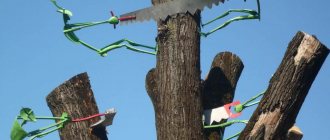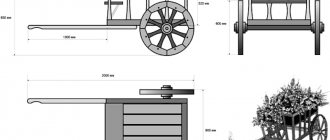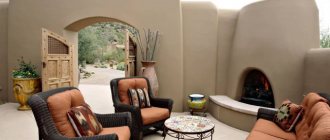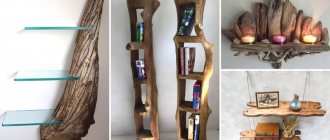Topiary art is the process of creating landscape sculptures from living plants.
It first appeared in the days of Ancient Rome, where owners of rich houses decorated their gardens with figuratively trimmed plants. In such parks everything was subject to strict symmetry, every leaf had to be in its place. Therefore, true masters were highly valued; there was a special guild, joining which was a great success. The heyday of topiary art came during the Renaissance, when every park had perfectly trimmed hedges and amazing figures made from living plants. At this time, the trendsetter of park fashion was no longer Italy, but France. The popularity of topiary had virtually no geographical boundaries. In Russia, its most striking examples were the gardens in the vicinity of St. Petersburg.
Many of the baroque masterpieces of park architecture have survived to this day. Today they are carefully restored and are open to visitors.
Techniques for forming topiary figures
Most often, topiary is created from evergreen plants with a very dense crown. They allow you to make the most dense figures with the correct outlines. Since the history of topiary art goes back several centuries, and it developed in different countries, branches inevitably arose. There is no clear gradation of styles. But there are various techniques for creating living sculptures, each of which has its own characteristics.
Classical technique
This is exactly the way that figures have been formed from plants since the times of Ancient Rome. It consisted of cutting and giving a certain shape. While there weren’t many problems with creating geometrically correct hedges, creating complex sculptures took several years and required special skills.
To create sculptures of the correct geometric shape, special frames made of wooden slats and ropes were used, which served as markers for cutting. Creating rounded shapes, for which it is difficult to assemble a frame, required special markings. For this purpose, chalk or tape was used to help measure the spiral.
Modern topiary compositions made using classical technology can also include grafting. In this case, coniferous and deciduous plants or varieties of the same species with different foliage colors can grow on the same trunk.
Frame technology
During the heyday of topiary’s popularity at the turn of the 18th and 19th centuries, this art spread widely throughout the world. At the same time, a radically new technology appeared that made it possible to relatively quickly form sculptures of complex shapes. To use it you do not need to be a specialist or study for a long time. It is believed that the creators of the technique were American gardeners, which is why it was called “American” or “new” topiary.
Using a specially made wire frame, it was possible to very quickly create a sculpture even from slow-growing species. On the one hand, this made commercial sense, and on the other hand, it allowed poor owners of garden plots to decorate them themselves.
"Green Art"
Over time, the process of growing a plant inside a wire frame seemed very long to landscape designers. Therefore, almost instantaneous methods for obtaining green sculptures were invented. To date, three methods have been developed:
- frame filled with sphagnum;
- frame with soil mixture on which annuals are planted;
- frame entwined with fast-growing small-leaved vine.
In open gardens and parks, such compositions are created for one season, but if there is a warm room they can be saved for the winter.
Making a garden figure a reality
Frame
Carefully draw the image of the future animal in your imagination - and then you can begin creating the sculpture. Transfer the shape of the animal onto the wire by bending it and securing it with binding wire. You can use welding to secure the frame, but it’s easier to do this with regular wire. The bottom of the future sculpture must be wrapped in a net and specially prepared soil must be poured there. Preparing it is quite simple: you just need to add nutrients and straw - and the frame is ready, filled with earth.
Green cover
Next, you should plant grass and flower seeds. You should not forget that you are making an animal. It is necessary to highlight the eyes, nose and skin pigmentation. It is preferable to make the nose pink, while the eyes should contrast with the color of the grass. Skin pigmentation is best done with variegated colors. Don't forget to water your creation! To prevent the soil from being washed away, you need to water your animal carefully.
The first attempts may not be particularly successful, but you shouldn’t be upset. Creating such sculptures will greatly excite you, and over time everything will work out! The main thing is not to stop and improve in this matter! We are absolutely sure that after a while your garden will turn into a menagerie. We recommend reading the article about garden figurines from kolobok to forester.
Materials and tools for creating topiary
To create a classic topiary, you do not need specific tools or materials. What the summer resident always has on hand will be enough. To create guides that allow you to accurately indicate the shape of the future plant, you need:
- wooden planks of different lengths;
- rope;
- hedge trimmer or garden shears, secateurs.
For the frame principle of formation you will need:
- flexible stainless wire;
- metal scissors or wire cutters;
- pliers.
All this can be replaced with a ready-made frame purchased in a store. Then you only need plants and small pieces of twine.
To create topiary using Green Art technology you need:
- metal carcass;
- moss or fertile soil.
Plants and flowers to create green shapes in the garden
To form topiary using the classic or frame method, plants are selected according to the following characteristics:
- crown density;
- the ability to form replacement shoots at any age;
- the presence of a large number of dormant buds.
In different climatic zones, different types and varieties are chosen for these purposes. For central Russia, the following are best suited:
- deciduous trees - wild pear and apple, willows, small-leaved linden and elm, Tatarian maple;
- conifers - common and prickly spruce, common and Cossack junipers, thuja occidentalis or emerald, Siberian larch;
- shrubs - barberries (Thunberg and common), viburnum leaf, hawthorn, alpine and golden currants, cotoneaster.
For a Green Art sculpture, you need to select succulents, climbing plants and ground cover plants that can cover the entire sculpture with greenery in a short period of time. In this case, the loaches are planted on the widest horizontal surfaces, and small elements are covered with succulents.
Having chosen a garden sculpture, which is created using a metal frame and climbing plants, it is worth focusing on such crops as:
- small-leaved varieties of virgin grapes;
- clematis;
- bryony;
- ivy;
- hop.
Technique #3 – classic topiary
Of course, the ancient Roman gardeners could not even imagine how much modern society would transform classical park art, similar in concept to sculptural modeling. Indulging in topiary, they did not at all try to speed up the process of creating a living sculpture; on the contrary, they found charm in the leisurely search for the ideal form. If the classical approach is closer to your spirit, then you can make topiary the way the Romans created it, and after them the gardeners of the 18-19 centuries. What is needed for this? A lot of patience, imagination and well-honed tools: garden or trellis shears, loppers, pruning shears, wooden slats.
A combination of trimmed borders and pyramid-shaped topiary clearly separates the lawn from the path
Here are some tips on how to make a classic topiary. It is best to start “sharpening” your skills with simple geometric shapes. Moreover, a simple three-dimensional figure can easily be complicated by transforming it into another - turning a cube into a ball, a cylinder or a pyramid - into a cone.
Pyramidal topiaries, towering against the background of spherical bushes, create an unusual contrast of shape and color
Topiary of a simple geometric shape
You need to start by identifying the “patient” for your first exercises. So, let's go on a search. Your goal is a tree or bush aged 5 years or older, with a well-developed root system and a crown larger than the intended size of the figure. Good options for making topiary, choose from plants such as Norway spruce or prickly spruce, brilliant cotoneaster, purple bladdercarp, pinnately incised hawthorn, and Tatarian maple. Topiary cutting is best done in March or April, or from June to August, but not in the fall, so as not to weaken the plant before wintering.
Topiaries of complex geometric shapes take years to create - they require painstaking trimming of the crown as it grows
Here are step-by-step instructions that will help you make a topiary in the form of a cube:
- On the ground, under the crown of a tree, you need to draw a square with the desired length of the side of the cube.
- At the corners of the square, install wooden slats or bamboo sticks with a diameter of 2-3 cm and fasten them together with horizontal transverse strips - this will be your reference frame.
- Using trellis scissors, make a rough cut, outlining the approximate contours of the figure - start with the top edge, then work on the sides.
- After checking the sides of the cube for curvature, correct the planes and proceed to a final cut, gradually trimming the volume.
- Apply the finishing touch with pruning shears, removing small branches that stand out from the total mass.
It is important to know! Periodically move 3-4 meters away from the topiary to evaluate the correctness of the form from afar.
A gazebo made of grapes exists harmoniously next to the unusual landscape created with the help of topiary on the lake shore
Topiary of complex shape
A topiary in the form of a ball can be made from a cube by truncating its edges. The most suitable plants for a spherical topiary: purple willow, Thunberg barberry, bladderwort, western thuja, gray spirea, common spruce, yew, boxwood and many others.
A spherical topiary molded from a standard tree will look impressive both in a regular and landscape landscape
A cylindrical topiary can usually be easily made from Thuja occidentalis, a variety of which is naturally column-shaped. Good cylinders can also be obtained from European larch, serviceberry roundifolia, and small-leaved linden. The principle of cutting a columnar topiary is the same as a cubic one. Under the crown of the tree you draw a circle, install guide wooden stakes and, bolder than the cube you conquered, cut out a cylinder.
Topiaries in the form of a cone and a truncated cone look good. In order to build a frame for a cone-shaped topiary, dig in at least three poles and fasten them in the center, at the imaginary top of the future cone - like an Indian wigwam. Again, nature itself comes to the aid of beginning topiaries, creating thuja occidentalis with a cone-shaped crown “smaragd”.
Cutting topiary in the form of clouds or “pompoms” creates the effect of a landscape of extraterrestrial origin
Topiary in the form of cones or columns can serve as an excellent frame for a green path leading to a fantasy arch
By training your hand steadiness, you can later try your hand at making pyramidal topiaries with three and four sides, arranging a mini-complex of Egyptian pyramids in your garden, giving your site a completely unique look. Having brought your skills to perfection, you will smoothly move on to creating such complex green sculptures as a spiral, tiered geometric volumes and their combinations, and not far off - to the figures of animals and people.
Thanks to modern vision, topiary is taking on more and more complex and unexpected forms.
Frame technology
This method of forming topiary is much simpler to perform, but allows you to create more complex sculptures. It consists of putting a lattice wire frame on a young plant. Over time, greenery fills the entire internal space, and shoots protruding through the cells cover the wire. The owner can only trim the overly protruding branches in time.
It is important to correctly calculate the required number of plants. For a small figurine, one bush is enough. For the middle one, located vertically - two. For a figure with a large horizontal projection, you need at least four bushes.
Plants are introduced into the frame at the age of 4–5 years. To avoid damaging the crown, it is better to wrap it with cling film before the procedure. Inside the frame, the film is cut off, and the plant is positioned so as to fill the maximum space. For beginners, it is better to choose sculptures without narrow protruding elements: it is much easier to fill them with shoots.
Once the plants are inside the frame, the branches need to be distributed as evenly as possible and secured with wire or pieces of twine. Strongly protruding parts of the plant are cut off with pruning shears or garden shears. All that remains is to wait until the green mass fills the entire structure, periodically cutting off or tucking in the shoots growing outward.
"Green Art"
The technology for creating a Green Art object consists of filling the same frame with sphagnum mixed with peat. The mixture should be wet enough so that the formed lump does not fall apart. It is better to start filling with the smallest elements towards the center of the structure. As a rule, special opening hatches are made in factory frames for ease of filling.
The completed structure can be left as is. Over time, the moss will grow out and fill the cells. If you want something more decorative, plants are planted in cells, leaving some space for growth. If vines are used, the growing vines are pinned to the ground with garden pins.
#TOPIARY FIGURES
#TOPIARY SCULPTURES FROM ARTIFICIAL LAWN
#STREET FIGURES FOR IMPROVEMENT
Green sculpture from artificial turf “Spring” Topiary “Jug” from artificial grass Topiary figure from moss “King Kong” Topiary figure from artificial turf “Bear” Topiary figure from artificial turf “Eagle”
Topiary figure “Volkhov Whitefish” Topiary flowerpot “Cow”
Topiary figures artificial turf Green artificial grass sculptures “Lovers”
Artificial turf topiary figure “Mistress of the Copper Mountain”
Green sculptures from artificial grass “Lovers” Green topiary figures from artificial grass “Quartet” Green sculpture “Spring”. Design of the festival “Moscow Spring” - 2016. Topiary figure “Donkey with viola” Topiary figure from artificial turf in the city of Berezovsky “Mistress of the Copper Mountain” Topiary frame with flowers “Crown” Green topiary figure “Cat” Topiary figures “Bear” and “Goat” from artificial turf Urban sculpture “Moose” ” from artificial turf Topiary from artificial grass “Bear - Fisherman” Topiary from artificial grass “Lady and Cavalier” Green topiary sculptures from artificial grass “Couple” Topiary animals from artificial turf “Bear with a bear cub” Topiary figure – flower garden “Rook”
3D topiary figures made of artificial grass “Quartet” Green topiary figure “Spring” with fresh flowers. 4.5m. www.topiart.ru Topiary figure “Elk”, Tikhvin Decoration of courtyards for landscaping Green topiary figures “Quartet” Topiary “Lion” from artificial turf
Topiary “Cyclists” Design of Tverskoy Boulevard, Moscow Festival “Moscow Spring” 2016, green figure “Flower Girl” Topiary artificial grass “Bear” Street topiary figures 3D artificial grass “Lady and Cavalier”
Large outdoor flowerpot “Cup” Topiary sculptures made of artificial grass “Cavalier and Lady” Topiary figure – flower garden “Drakar”, Vyborg Topiary figure “Hippopotamus” made of artificial boxwood Topiary figure made of artificial boxwood “Hippopotamus” Green sculptures “Lady and Cavalier” Topiary from artificial boxwood “Behemoth” Topiary letters from artificial grass “Kolomyagi”, St. Petersburg Topiary from artificial grass “Lady and Gentleman” www.topiart.ru Topiary figure “Mammoth” from artificial turf Topiary figure “Earth” Topiary “Couple” Topiary figure “Baby Elephant” Topiary fountain “Hand” Moscow Urban design and landscaping green figure “Flower Girl” Vertical gardening design “Flower Wall” Topiary “Monkey” from lichens MAF “Baby Mammoth” Topiary figure “Race car” from artificial turf Green 3D figure “ Globe Topiary figures from artificial turf “Bear with a bear cub” Topiary “Letters” from moss Landscaping and decoration of streets green figure from artificial turf “Little Elk Kiryusha” Kirovsk Topiary figure “Camel” Topiary from moss “Elephant” Topiary “Bull” Topiary from moss “Bear” Topiary “Snail” Topiary “Turtle” from moss Topiary “Flower Girl” Topiary “King Kong” from moss Topiary sculpture “King Kong” Topiary frame “Crown” Garden figurine topiary from moss “Pelican” Topiary frame “Crown” Topiary “Bull” from moss and sedum Topiary “Elephant” from white moss Vertical gardening design “Green wall” Topiary sculpture “Elefant” Topiary “Shepherd with a sheep” from moss Topiary figure from artificial plants “Heron” Topiary figure “Frog” Topiary “Frog” “Topiary figure “Marabou” Topiary figure made of artificial boxwood “Flamingo” Topiary figure “Bird” made of artificial boxwood
Topiary letters from artificial turf Green topiary figure from artificial turf “Lion” Topiary figures “Lovers” “Topiary “Lion” Topiary “Turtle” Topiary “Hippopotamus” from artificial boxwood Topiary “Bear with a basket” Topiary from moss “Horse” “Green figure 3D artificial grass “Flower Girl” Green topiary figure from artificial turf “Elk”, Gatchina Green topiary sculpture “Leprechaun” from artificial grass Topiary figure “Horse” Topiary figure “Donkey” from artificial grass Green figure from artificial turf “Lion” Garden figure “Donkey”
Topiary figures from artificial turf in the design of the yard Topiary “Dragon” from artificial turf Garden figurines “Deer” “Lovers” green figures in St. Petersburg, Fontanka 90. Topiary “Cat” Figure of a lion Topiary figure “Headphones” Topiary figure from artificial turf “ Dragon” Topiary “Deer” artificial boxwood
Topiary “Deer” Topiary figure “Duck” from boxwood Topiary “Couple” from artificial grass Topiary “Horse” Topiary figure from artificial grass “Lion” Topiary figure “Leprechaun” from artificial turf Topiary “Leprechaun” artificial turf Topiary figures for the street from artificial lawn “Leprechaun” Topiary from artificial turf “Cook” Topiary from artificial turf “Cook” Topiary figures from artificial turf “Service” Topiary figure – flowerpot from artificial turf “Cup”
Volumetric topiary letters from artificial turf Topiary sculpture by Rashid Kasimov “Hand” in the Russian Museum of St. Petersburg Topiary “Lady” Topiary “Lovers” Topiary “Footballers” Topiary figures of people Topiary figure “Footballers” Topiary figure from artificial turf “Cyclist” Topiary figure “ Boy on a bicycle” Green figure “Elk”, Gatchina Topiary from artificial turf “Soccer Ball” Topiary figure from artificial turf “Elk Calf” Topiary “Jug” Topiary figures of people in urban design
Decoration of the children's playground installation “Balls and Cubes”
Topiary “Bear with a Heart”
Plant garden topiary sculptures. How to make and how to use read here...
Important nuances when creating topiary figures
- It is better to start with simple geometric shapes, gradually moving on to more complex ones.
- For figures with sharp corners and small elements, it is better to choose plants with small leaves or needles.
- Do not start formed plants. If you do not cut them for more than 2 years, there is a high probability that you will no longer be able to return to their former shape.
- After pruning, variegated plants become much brighter due to the young leaves; take this into account when forming the composition.
- Objects created using Green Art technology require constant abundant watering by sprinkling or drip irrigation.
- If it is not possible to bring a figure planted with annuals indoors for the winter, propagate or replant the plants covering it and bring them into the greenhouse. This is especially true for slow-growing succulents.
Green topiary sculptures
Surely you already know that topiary is trees and shrubs trimmed in a certain way. Green sculptures in the form of balls, columns, and entire gazebos could be found in the palaces of noble nobles and rich aristocracy.
It is believed that the founder of this amazing technique was a gardener named Kalvena who looked after Caesar’s lands. The ruler liked the way the latter cut the tree figuratively so much that he demanded that his domain be decorated only with such beautiful sculptures.
Later, the same gardener carved a bust of Caesar from a large bush, for which he was generously rewarded. In the Roman Empire, a master who knew the art of topiary was valued at the cost of several dozen slaves, but he himself was not one, but rather a close associate and passed on his knowledge only to the best students. With the expansion, the model haircut also spread. Each province brought something new, and soon even schools of “figurative” art appeared.
At the same time, artistic cutting of plants developed in the East. True, there it turned from an element of landscape design into a postulate of philosophy and began to be called “bonsai”. The owner could not receive guests in the garden unless an architect worked there. Gazebos, corridors and even Buddha statues were carved from plants. But still, this action was different from the topiary art of other countries.
In Russia, such skill spread under Peter I, who had heard a lot about outlandish bushes and trees of unnatural shapes growing in the gardens of the rulers of Europe. He ordered the gardeners of his yard to immediately study all the intricacies of this matter, which is why he sent them abroad. Upon returning home, they immediately set to work in the new city - St. Petersburg. But foreign bushes and trees did not tolerate Russian frosts well, and therefore they had to look for domestic analogues. They were rowan, spruce, linden, juniper, bird cherry.
In our 21st century, there are no longer any specific styles in landscape design. In almost all gardens, several options are mixed at once, which leads to a little creative chaos. Designers strive to give the site a natural look, but with visible elements of the gardener’s handiwork. Plants processed using the topiary technique immediately attract the eye, and therefore they are almost always located in the middle of any group of plantings, near the house or in the central areas of the site.
It should be noted that these compositions look good only in large spaces. Although the owners of six acres also place a mini-sculpture, made quite figuratively. So the owner of any area can feel like a king and get his own Versailles.
Topiary care
Caring for decoratively trimmed or framed plants should be a little more careful than for plants of this type that grow freely:
- In addition to decorative pruning, sanitary and thinning pruning should be carried out within the recommended time frame for this species. This is especially true for some types of conifers, the crown of which does not tolerate thickening.
- Regular pruning of plants stimulates the active growth of new shoots. To do this, it requires large amounts of nutrients, especially in hedges where the root systems are very close to each other and compete. Therefore, it is very important to feed topiary regularly. At the beginning of the season it should be nitrogen or complex fertilizers, and in the second half - potassium and phosphorus.
- The soil around the topiary should always be loose and well mulched.
By following all these rules, you can make your site unusual and attractive by creating amazing green shapes on it.


